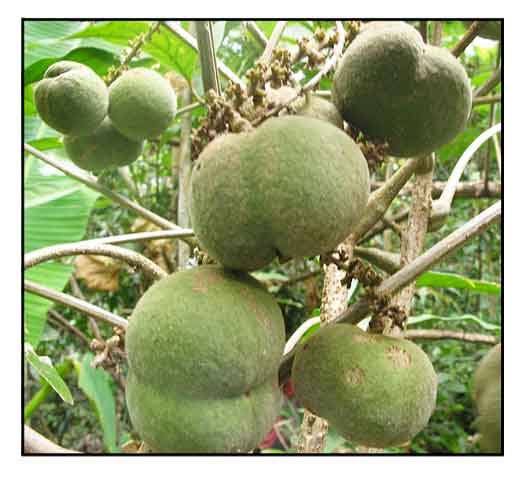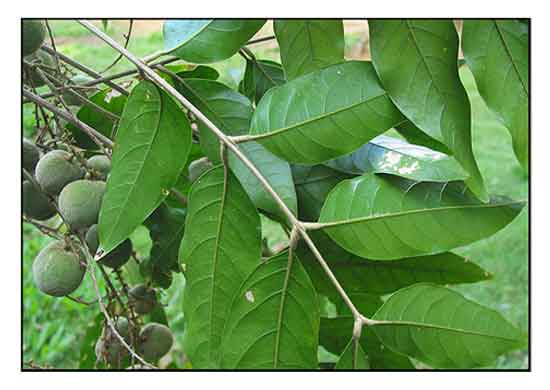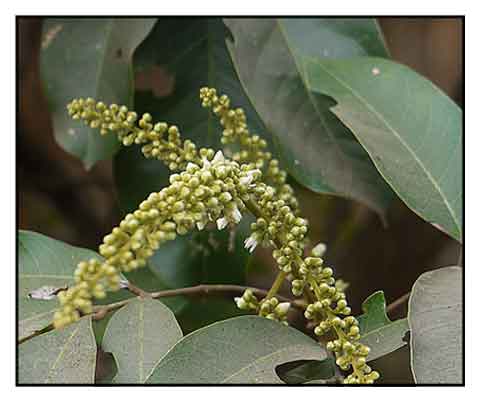
Family • Sapindaceae
Bayag-daga
Lepisanthes tetraphylla (Vahl) Radlk.
TORCHWOOD
| Scientific names | Common names |
| Anomosanthes tetraphylla (Vahl) Pierre. | Bayag-daga (Tag.) |
| Lepisanthes tetraphylla (Vahl) Radlk. | Pospos (Tag.) |
| Sapindus tetraphyllus Vahl | Sarakag-tilos (Phil.) |
| Accepted infraspecifics | Four-leaved soapnut (Engl.) |
| Lepisanthes tetraphylla var. tetraphylla | Torchwood (Engl.) |
| Lepisanthes tetraphylla var. trichocarpa (Thwaites) Wadhwa & Meijer | |
| Lepisanthes tetraphylla (Vahl) Radlk. is an accepted name. KEW: Plants of the World Online | |
| Other vernacular names |
| INDIA: Katu yette (Kannada), Lokhandi (Konkani), Kalpoovathi, Kulappunna, Naikolli, Poovalmaram, Naaukkolli (Malayalam), Karpa, Lokhandi (Marathi), Kuhamathi, Kuhamathi, Nehotaa, Nekota, Neykkoddaan, Poovanti (Tamil), Or korivi, Koravi (Telugu), Kurpa. |
| INDONESIA: Katilayu watu. |
| MALAYSIA: Arit-arit, Bansisi, Jung. |
| THAILAND: Ma fueng chang, Ma fueng pa, Ma kham de khwai. |
| VIETNAM: Gio khoi, Vo khoi. |
January 2023
![]()
 |
| PHOTOS / ILLUSTRATIONS |
| IMAGE SOURCE: Photo: Sapindaceae : Lepisanthes tetraphylla / fruits / Copyright © 2011 Leonardo L Co [ref. DOL26624] / Non-Commercial Use / click on image to go to source page / Phytoimages.siu.edu |
| OTHER IMAGE SOURCE: Photo: Sapindaceae : Lepisanthes tetraphylla / Leaves / Copyright © 2011 Leonardo L Co [ref. DOL26630] / Non-Commercial Use / click on image to go to source page / Phytoimages.siu.edu |
| OTHER IMAGE SOURCE: Photo: Sapindaceae : Lepisanthes tetraphylla / Dinesh Valke / Creative Commons Attribution-Share Alike 2.0 Generic / Wikimedia Commons |
| IMAGE SOURCE: Photograph: Blood lily--Scadoxus multiflorus / Jim Evans / CC by SA 4.0 / click on image to go to source page / Wikipedia |
OTHER IMAGE SOURCE: Photo: Scadoxus multiflorus / image modified / © World of Succulents / click on image to go to source page / World of Succulents |
| OTHER IMAGE SOURCE: Photo: Scadoxus multiflorus berries / Maja Dumat / CC by 2.0 / click on image to go to source page / North Carolina EXTENSION GARDENER Plant Toolbox |
| IMAGE SOURCE: Hedyotis costata / Subject Database of China Plant <http://www.naturemuseum.net/album/ShowPhoto.aspx?photoid=2671c974-77ca-44f9-b304-0f16660a06f7> Helixcn |
| OTHER IMAGE SOURCE: /Gliricidia sepium (Jacq.) Kunth ex Walp. - quickstick GLSE2 / Steve Hurst @ USDA-NRCS PLANTS Database / USDA |
| OTHER IMAGE SOURCE: / Photo / Rutaceae : Lunasia amara det. John Rey Callado / Leaf / Copyright © 2012 by P.B. Pelser & J.F. Barcelona (contact: pieter.pelser@canterbury.ac.nz) [ref. DOL52015] / Non-Commercial Use / Phytoimages.siu.edu |
| IMAGE SOURCE: / Photos (2) / Pterocaulon redolens (Willd.) F.-Vill. / © Collected by www.plant.ac.cn / ZHIWUTONG / CLICK ON IMAGE TO GO TO SOURCE PAGE |
| IMAGE SOURCE: / Line drawing / Pterocaulon redolens (Willd.) F.-Vill. / © Collected by www.plant.ac.cn / ZHIWUTONG / CLICK ON IMAGE TO GO TO SOURCE PAGE |
| OTHER IMAGE SOURCE: / Photo / Rutaceae : Lunasia amara det. John Rey Callado / Leaf / Copyright © 2012 by P.B. Pelser & J.F. Barcelona (contact: pieter.pelser@canterbury.ac.nz) [ref. DOL52015] / Non-Commercial Use / Phytoimages.siu.edu |
| OTHER IMAGE SOURCE: / Flower close-up / dracobotanicus -- Wayne Dumbleton / Creative Commons Attribution / flickr / Click on graphic to see original image / flickr / |
| OTHER IMAGE SOURCE: / Illustration / Cissampelos pareira L. [5809-247450-161657] / Indian medicinal plants, vol. 1: t. 42 / PlantIllustrations.org |
| flickr / |
| Pacific Island Ecosystems at Risk (PIER) |
| Photos ©Godofredo Stuart / StuartXchange |
| Content © Godofredo Stuart / StuartXchange |
| Content / Photos © Godofredo Stuart / StuartXchange |
| Photos © Godofredo Stuart / StuartXchange |
Additional
Sources and Suggested Readings |
• |
DOI: It is not uncommon for links on studies/sources to change. Copying and pasting the information on the search window or using the DOI (if available) will often redirect to the new link page. (Citing and Using a (DOI) Digital Object Identifier) |
| List of Understudied Philippine Medicinal Plants |
• |
 |

 Gen info
Gen info

